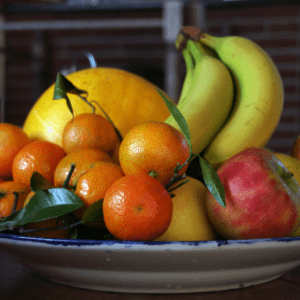
Exotic Fruits are a Symbol of Wealth
During the Tudor period, exotic fruits were considered to be a symbol of sophistication and wealth. King Henry VIII enjoyed a variety of fruit during his reign, and often had it imported from countries such as Spain, to please Catherine of Aragon. Fruits like this were not often seen in England, showcasing the opulence of the royal court. Queen Victoria’s reign also saw the creation of Cherries Jubilee, a sweet dish that used cherries, flambéed and served with traditional vanilla ice cream. Renowned chef Auguste Escoffier prepared it in honour of the Jubilee celebration, again, highlighting the royal link between fruit and opulence.
The enduring appeal of fruit is also present in modern entertainment too. Shows like the Great British Bake Off see contestants often creating fruit pies, tarts, and more. Artists, such as Kate Malone, have also incorporated fruit in their work, with a notable example being Sliced Fruit of Your Dreams, which can be seen at the Bristol Museum & Art Gallery. Fruit is also a classic symbol in casino games. Classic slot machines from the 1900s used apple, cherry, and orange symbols with non-cash payouts. Flavoured fruit gum was instead distributed, as a way to change up the game. To this day, even the best Megaways slots still incorporate the classic fruit theme, with rich features, engaging themes, several bonus features, and innovative gameplay. If you sign up with a casino UK, you’ll notice that modern games, such as Hot Joker Fruits Hold and Win contain symbols such as watermelons, cherries, and lemons, paying homage to the elegance of fruit and its rich history. Symbols like this act as a sign of prosperity, indicating the chance of winning, in a game of chance.
Popular Royal Dishes
The Royal Sovereign Strawberry, developed in 1892, quickly became one of the most popular varieties of the 20th century. It was served at Queen Elizabeth’s coronation banquet in 1953 and helped to show how invested the Royal Family were in locally sourced, quality fruit. Queen Camilla’s son, Tom Parker Bowles, has also noted that the royal diet often emphasises seasonal and simple ingredients, with fruit having a huge part to play. You also have the tradition of serving fruitcakes at royal weddings, which, again, serves as a symbol of wealth and prosperity. The rich ingredients, which include dried fruit and spices, have helped to influence several matrimonial traditions across the world.
In conclusion, fruits have been integral to the royal family’s cultural heritage. From historical feasts to contemporary dishes, it’s safe to say that fruits symbolise tradition as well as the pleasure of being able to dine in luxury, with a great appreciation of simple ingredients.